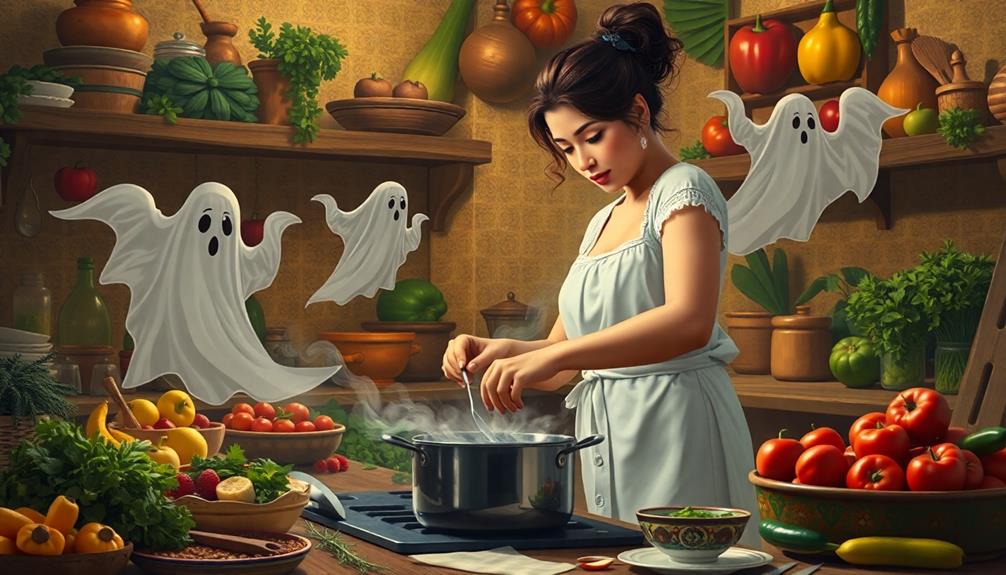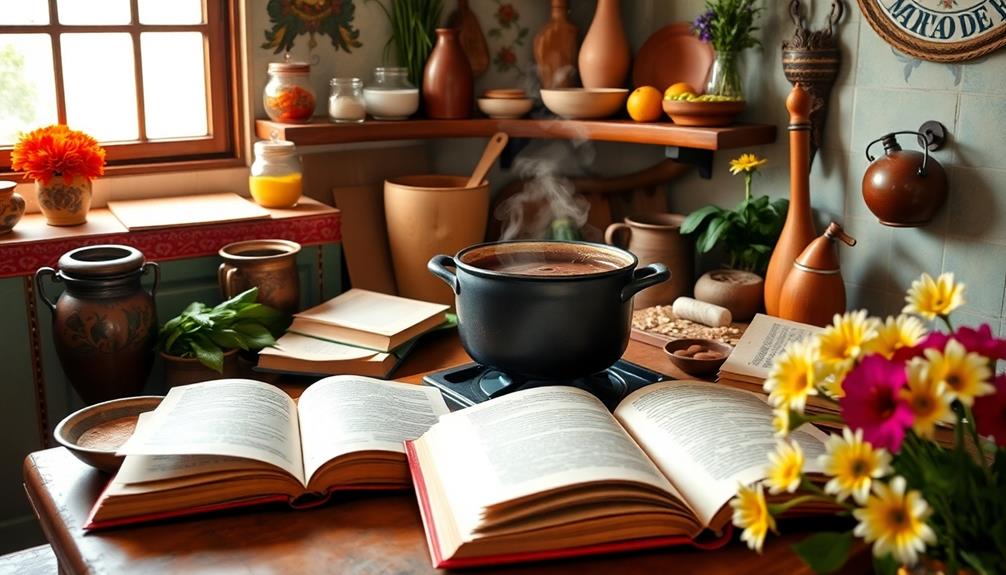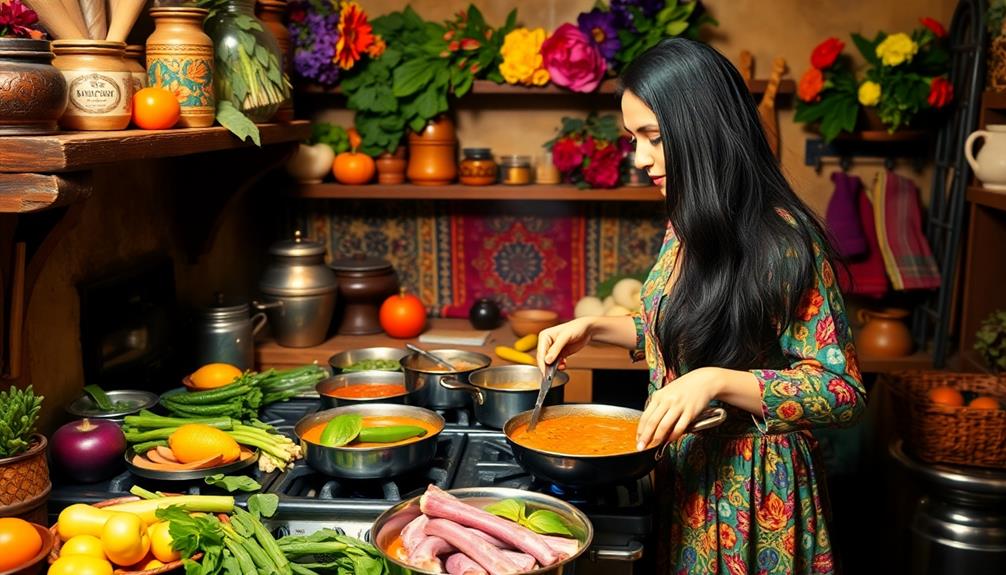You'll meet Laura Esquivel, the visionary author of "Like Water for Chocolate," born in Mexico in 1949. Her novel blends magical realism with the rich tapestry of family traditions and love. Through main character Tita, Esquivel explores the emotional connections between food and personal struggles. Each chapter features recipes that capture Tita's feelings, highlighting how cooking embodies empowerment and despair. This compelling narrative not only sold millions of copies but also sparked discussions on gender roles and cultural identity. If you stick around, you'll uncover even deeper insights into her life and the impact of her work.
Laura Esquivel's Early Life
Laura Esquivel, born on September 30, 1949, in Ciudad Guzmán, Mexico, grew up as the third of four children in a modest family. In this nurturing environment, her mother played a pivotal role, instilling in her a deep appreciation for love and the importance of family.
You can see how these early influences shaped Esquivel's writing, particularly in her exploration of themes of passion and personal growth. As a child, she often observed her mother preparing meals, where the act of cooking became a symbol of care and affection. This connection between food and love would later become a central theme in her work.
After completing her education in Theatre and Dramatic Creation at Centro de Arte Dramático A.C., she honed her skills in storytelling and performance, which laid the groundwork for her future as a novelist.
Esquivel's shift from screenwriting to novel writing in the late 1980s marked a significant change in her career. Yet, the essence of her upbringing—her mother's love, family bonds, and traditional values—remained at the heart of her narratives, enriching her debut novel, "Like Water for Chocolate," with profound emotional depth.
Overview of Like Water for Chocolate
"Like Water for Chocolate" is an enchanting tale set in late 19th-century Mexico that follows the life of Tita, a young woman trapped by family traditions that prevent her from marrying the man she loves.
As you read, you'll discover how each chapter features a recipe that mirrors Tita's emotional state, illustrating the profound connection between her cooking and her experiences. This interplay highlights her feelings of love, longing, and heartache, making her culinary creations even more significant.
The novel's themes resonate with the culinary experience at Water for Chocolate, where dishes tell stories of passion and creativity, reflecting the essence of family traditions.
The novel employs magical realism, where Tita's cooking has extraordinary effects on those who consume her meals. This unique narrative technique symbolizes her suppressed emotions, allowing her to express herself in a world that confines her.
The phrase "like water for chocolate," which refers to intense emotions, especially boiling passion, serves as a powerful motif throughout the story.
Since its publication in 1989, "Like Water for Chocolate" has received widespread acclaim, translated into over 35 languages and adapted into a successful film in 1992.
This work stands as a landmark in Latin American literature, enchanting readers with its exquisite blend of love, food, and magic.
Key Characters and Their Roles

In "Like Water for Chocolate," Tita's emotional journey showcases her struggle against the suffocating traditions imposed by her mother, Mama Elena.
The oppressive environment she faces is reminiscent of the challenges characters in Nazi Germany during World War II endure, highlighting the theme of resilience against adversity.
You'll see how Pedro's unrequited love complicates the dynamics, as he marries Tita's sister to stay close to her while yearning for what he can't have.
Together, these characters highlight the deep conflicts between personal desire and family duty.
Tita's Emotional Journey
As Tita navigates her oppressive family dynamics, her emotional journey unfolds amidst the constraints imposed by her mother, Mama Elena. Bound by an unyielding family tradition, Tita's heartache runs deep, especially as she grapples with her love story involving Pedro, who marries her sister Rosaura to stay near her. This complex web of relationships leads you to feel Tita's longing and despair.
Key elements of Tita's emotional journey include:
- Isolation: Tita often feels alone, trapped by her mother's expectations.
- Longing: Her love for Pedro fuels her emotional turmoil and desire for freedom.
- Rebellion: Inspired by Gertrudis, Tita begins to explore her own desires.
- Nurturing: Through cooking, Tita channels her emotions, creating connections with others.
- Growth: Each experience shapes Tita, pushing her towards self-discovery and empowerment.
This intricate tapestry of love, pain, and resilience makes Tita's emotional journey a poignant exploration of personal freedom against societal constraints, inviting you to reflect on the weight of tradition and the power of love.
Mama Elena's Authority
Mama Elena's authoritarian grip on her family shapes the lives of her daughters, particularly Tita, whose dreams clash with rigid traditions. As the matriarch, Mama Elena enforces the family rule that the youngest daughter must remain unmarried to care for her. This oppressive expectation becomes a central conflict in Tita's life, stifling her autonomy and desires.
You see, Mama Elena's strict adherence to traditional family roles reflects broader societal constraints on women in Mexican history.
Her emotional and physical abuse towards Tita emphasizes her harsh nature, leaving Tita feeling trapped and helpless. Despite this, Mama Elena embodies the cultural expectations of her time, symbolizing the struggle between tradition and personal desire.
You can't overlook how her character represents the generational conflict that many women faced, caught between cultural obligations and their own aspirations.
Ultimately, Mama Elena's authority serves as a pivotal force in Tita's journey toward self-discovery and rebellion. By highlighting these tensions, Esquivel invites you to reflect on the limitations imposed on women through the lens of Mama Elena's oppressive authority.
This dynamic enriches the narrative, making it a profound exploration of family, tradition, and personal freedom.
Pedro's Unrequited Love
Tita's struggle against the constraints imposed by her mother is mirrored in the heart-wrenching experience of Pedro Muzquiz, her love interest. Pedro's unrequited love for Tita showcases the emotional turmoil and longing that permeate their relationship. He marries Tita's older sister, Rosauro, not out of love, but to stay close to Tita, highlighting the conflict between personal desire and familial duty.
Pedro's character embodies the complexity of love constrained by societal expectations. Here are some key aspects of his role in the narrative:
- Steadfast Affection: Despite his marriage, Pedro's love for Tita never wavers.
- Subtle Gestures: He expresses his feelings through small acts of kindness, revealing his deep emotional connection.
- Emotional Turmoil: Pedro suffers silently, caught between his love for Tita and obligations to Rosauro.
- Symbol of Sacrifice: His decisions reflect the sacrifices made for love under societal pressure.
- Tension: The ongoing conflict between his desires and duties exemplifies the struggle within the family dynamic.
Through Pedro Muzquiz, Esquivel masterfully illustrates the pain of unrequited love, making his story resonate deeply with readers.
The Significance of Food in the Novel
Food serves as an essential thread weaving through the narrative of "Like Water for Chocolate," deeply connecting Tita's emotions to her culinary creations. Each chapter unfolds with a recipe that mirrors Tita's emotional state, showcasing how her cooking becomes a powerful narrative device. For instance, when she prepares a wedding cake infused with her tears, the guests weep uncontrollably, illustrating how her feelings directly influence those around her. This connection between food and emotional expression echoes themes found in literature that explore the immigrant experience, where survival often hinges on familial bonds and cultural traditions, as seen in the struggles of the Nolans in *A Tree Grows in Brooklyn* the immigrant experience.
The preparation and sharing of food symbolize love, loss, and the intricate dynamics of her family relationships. Dishes like quail in rose petal sauce evoke passionate reactions, creating chaos among the characters and revealing their hidden desires. The improbable quantities in her recipes amplify the fantastical nature of the story, emphasizing the magical connection between Tita's emotions and her culinary creations.
The kitchen serves as both a space of confinement and empowerment for Tita. It highlights her struggle against familial duty while demonstrating the transformative power of food and tradition in Mexican culture.
Ultimately, food in this novel isn't just sustenance; it's a reflection of Tita's journey and the emotional landscape that shapes her life.
Exploring Magical Realism

Magical realism blends the ordinary with the extraordinary, creating a unique narrative that reflects cultural complexities.
In "Like Water for Chocolate," Tita's emotional cooking transforms her dishes into vessels of magic, influencing those who eat them. This connection between food and feelings offers a vivid illustration of how magical realism enhances the story's emotional depth.
The themes of resilience and personal growth found in literature, such as the journeys depicted in personal growth stories, further underscore the transformative power of storytelling in capturing the human experience.
Definition of Magical Realism
In the domain of literature, magical realism stands out as an enchanting genre that seamlessly weaves fantastical elements into the fabric of everyday life. Originating from Latin American literary traditions, it reflects cultural myths and the impact of historical European colonialism.
Laura Esquivel's work, especially "Like Water for Chocolate," exemplifies this genre, blending realism with the extraordinary.
Here are some key features of magical realism:
- Blending of Real and Fantastic: Everyday settings host surreal occurrences.
- Cultural Roots: It draws on folklore and myths, enriching narratives.
- Emotional Depth: Works evoke strong feelings, connecting readers to cultural experiences.
- Social Commentary: Often highlights societal issues intertwined with magical elements.
- Personal Transformation: Characters often undergo profound changes through mystical events.
In Esquivel's storytelling, food becomes a vehicle for magical experiences, affecting the emotions and actions of those who consume it.
This unique approach not only entertains but also challenges readers to reflect on deeper social and familial dynamics.
Magical realism invites you to explore a world where the extraordinary coexists with the mundane, creating a rich tapestry that captivates the imagination.
Tita's Emotional Cooking
Tita's cooking transforms into a powerful expression of her emotions, where each dish carries the weight of her experiences and feelings. Influenced by her tumultuous relationship with her mother, Tita channels her sadness and longing into her culinary creations.
For instance, when she prepares a wedding cake, her tears seep into the batter, infusing it with profound sorrow. This emotional cooking doesn't just affect her; it evokes intense reactions from those who eat her meals. In a moment of magical realism, a dish can ignite passion or despair, resulting in chaotic scenes that mirror Tita's inner turmoil.
The phrase "like water for chocolate" encapsulates this boiling emotional state, highlighting how her feelings directly transform her cooking into something extraordinary. Each chapter features a recipe that serves not just as a narrative device but also underscores the cultural significance of food in expressing love, loss, and personal struggles.
Tita's culinary skills become a form of rebellion against her mother's oppressive rules, allowing her to assert her identity. Through her emotional cooking, Tita bridges the gap between her internal world and those around her, creating a magical connection that deeply resonates.
Cultural Context and Historical Influence
The cultural context and historical influence surrounding Laura Esquivel's "Like Water for Chocolate" are integral to understanding its narrative depth. Set against the backdrop of the Mexican Revolution (1910-17), the novel explores the social upheaval that shapes Tita's life and aspirations. This period emphasizes the struggle for democracy while highlighting traditional gender roles in Mexican society.
Tita's mother embodies these expectations, yet Tita's resistance portrays a powerful challenge to familial norms. Echoing the spirit of resistance seen in historical movements, Tita's defiance symbolizes the quest for justice and equality in a patriarchal society, reminiscent of the collective action against oppression observed during World War II.
Key elements of the cultural context include:
- The impact of the Mexican Revolution on personal identities and relationships.
- The traditional roles of women, especially in relation to family and duty.
- The significance of food as a means of communication and connection.
- The use of magical realism to express deeper emotional truths.
- The exploration of female empowerment and generational traditions.
Esquivel skillfully intertwines these themes, showcasing how Tita's journey reflects broader discussions on women's rights and identity in a changing society.
Understanding this cultural and historical backdrop enriches your reading experience, allowing you to appreciate the layers of meaning within the narrative.
Reception and Impact of the Novel

Laura Esquivel's "Like Water for Chocolate" resonated deeply with readers and critics alike, becoming a cornerstone of contemporary literature. After its release in 1989, it emerged as Mexico's best-selling book for three consecutive years, illustrating its widespread appeal and cultural significance. Selling over 4.5 million copies and translated into more than 35 languages, the novel has left a lasting mark on global literature.
The themes of love and resilience in the story echo the powerful narratives found in works like Unbroken, which showcase the triumph of the human spirit, further enhancing its universal relevance.
Critics celebrated its rich storytelling and thematic depth, earning the 1993 American Booksellers Association Book of the Year award. The narrative, which intertwines food, love, and politics, sparked important discussions around gender roles and cultural identity, positioning itself as a pivotal work in Latin American literature and feminist discourse.
The influence of "Like Water for Chocolate" didn't stop at the page; the 1992 film adaptation grossed greatly in the U.S. and won multiple awards, further solidifying its popularity.
Through its unique blend of magical realism and culinary imagery, especially centered around chocolate, Esquivel's novel has captivated hearts and minds, ensuring its place in both literary history and contemporary discussions in Mexico and beyond.
Adaptations of Like Water for Chocolate
Numerous adaptations of "Like Water for Chocolate" have brought Laura Esquivel's beloved narrative to life in various forms. The story's rich themes of love, food, and tradition resonate across different mediums, enchanting audiences worldwide.
These adaptations also echo the themes of healing and empowerment found in personal survival stories, illustrating how storytelling can unite and inspire. Some notable adaptations include:
- The successful 1992 film that grossed considerably in the U.S. and won ten Arieles.
- A ballet adaptation co-produced by the American Ballet Theatre and the Royal Ballet of London, which premiered in Los Angeles on March 29, 2023.
- An anticipated Broadway musical, originally postponed due to the pandemic, now set to debut in 2024.
- A television series adaptation based on Esquivel's trilogy, encompassing "Tita's Diary" and "The Colors of My Past."
- Ongoing discussions sparked by these adaptations about cultural identity and women's roles in storytelling.
These adaptations haven't only brought new life to Esquivel's story but also broadened its reach, inviting deeper conversations about the intersection of food, emotions, and culture.
Each new interpretation allows you to experience the magic of "Like Water for Chocolate" in fresh and exciting ways.
Esquivel's Legacy and Continuing Influence

Since its publication, "Like Water for Chocolate" has left an indelible mark on literature and culture, establishing Esquivel as a key figure in multicultural storytelling. Her novel, which has sold over 4.5 million copies and been translated into 35 languages, has become an important part of feminist literature. The successful film adaptation in 1992 further solidified her status, winning nearly two dozen international awards.
Esquivel's exploration of food, emotions, and women's roles resonates deeply with readers, inspiring a new generation of writers. Her unique blend of magical realism and cultural identity sparks important conversations about gender roles and societal expectations. Subsequent works like "Tita's Diary" and "The Colors of My Past" continue to investigate love and tradition, expanding her legacy and influence in literary circles.
Moreover, Esquivel's active engagement in political and social issues keeps her relevant today. She influences contemporary discussions around women's rights and cultural heritage in Mexico, ensuring that her voice remains essential.
In this way, Laura Esquivel's legacy isn't just preserved in her writings but continues to shape the literary and cultural landscape.
Conclusion
As you reflect on Laura Esquivel's journey, you can't help but notice the serendipity woven through her life and work—just like the flavors in her novel. 'Like Water for Chocolate' isn't just a story; it's a celebration of love, tradition, and the magical connections between food and emotion. You see how Esquivel's legacy transcends time, inspiring readers and writers alike, reminding you that sometimes, the most profound truths are found in the simplest coincidences of life.



